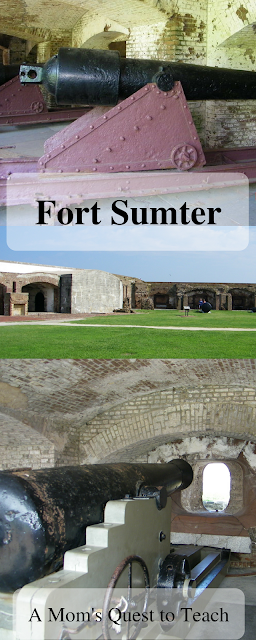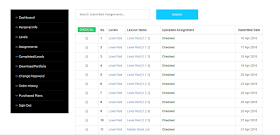This post contains affiliate links. For more information please see my Terms of Use and Disclosure Policy page. Thank you.
As you may know, I am focusing upon the subject of history for the "Blogging through the Alphabet" series this time. I have been blessed with being able to visit the beautiful city of Charleston, South Carolina twice now. I visited once with my mom and then again with my husband for our honeymoon. I would like to share a few of my favorite places as well as some history about Fort Sumter. I hope you enjoy the journey!

There are so many interesting things to see and do in Charleston – from Colonial History to World War II. It is mostly remembered for its part in the American Civil War due to Fort Sumter and the many plantations that one can still visit today in the surrounding area. When we visited Charleston, we toured
Boone Hall Plantation and Gardens,
Drayton Hall, and
Magnolia Plantation and Gardens. Boone Hall is known for the movies and TV series that have been filmed on location including North and South. Drayton Hall is a wonderful example of the preservation of history instead of restoration. And at Magnolia Gardens we were able to learn more about a rice plantation and see lots of wildlife in the swamps - even an alligator!
There are a great number of churches in Charleston. Being home to so many has resulted in it receiving the nickname, "The Holy City." This includes the
Circular Congregational Church – which is one of the oldest continuously worshiping congregations in the South.
We also got to visit the
Charleston Tea Plantation which produces American Classic Tea – the only brand of tea made of 100% exclusively American-grown tea.
Charles Towne Landing
At
Charles Towne Landing State Historic site, you can visit where a group of English settlers landed in 1670 and started the Carolina Colony just off the Ashley River. Being able to visit sites where the American colonies were founded is an excellent way to study history.
Fort Sumter
History remembers Fort Sumter as the first battle of the American Civil War. In fact, the first shot is recorded as having been ordered by Captain George S. James of the Confederacy on April 12, 1861 at 4:30 am. This started the bombardment of Fort Sumter in the Charleston Harbor.
Fort Sumter was part of America's coastal defenses that was authorized after the War of 1812. The Fort was built of bricks on a granite foundation enclosing a pentagonal parade ground. There would be a 3-story barracks that could house up to 650 men and there was room for 135 pieces of artillery.
In December of 1860, Major Robert Anderson moved his troops from Fort Moultrie to Fort Sumter. When Major Anderson and his men (about 85) arrived at Fort Sumter, it was not in the best condition. There were only 15 cannons mounted, it contained an unfinished barracks, and the parade ground still had building materials all over it. Major Anderson set his men to work mounting guns, bricking up holes, and completing other tasks to make it a working fort.
Both the North and the South continued to make preparations for war as time marched forward. New batteries were built along Sullivan's Island, James Island, and near Mount Pleasant. On March 1, 1861, General Pierre G. T. Beauregard took control of the military operations at Charleston. Beauregard had sent a message requested Anderson to leave but Anderson stayed put at Fort Sumter.
On April 4, 1861, President Lincoln decided to resupply Fort Sumter. This led to the supply from the city to the Fort being cut off and eventually Beauregard sent 3 men to offer an ultimatum to Anderson – evacuate or face the consequences of staying. Anderson refused to give up the Fort.
On April 12, 1861 at 4:30 a.m., a bombardment of 2-and-a-half hours began. Even though the men were relatively safe in the Fort, there wasn't really the chance that they would be able to do more than remain there during the siege. The cannons on the island were not successful at destroying any targets. On April 13, 1861 at 1:30 pm the Stars and Stripes was shot down and this led Louis T. Wigfall, former Senator from Texas, to travel to the Fort to ask about surrender. Anderson decided it was time to surrender and on April 14, 1861 the US flag at Fort Sumter was lowered to a 50-gun salute. Anderson and his men boarded a steamer to the North as heroes.
H. L. Hunley
The first submarine was used by the Confederacy during the Civil War. Rumor was that it actually killed more Confederates than Union soldiers during its testing and use. On February 17, 1864, the
Hunley slammed into the
USS Housatonic. It exploded its torpedo, the Union ship broke apart and sank, and so did the
Hunley. In 1995, it was found off the coast of Charleston.
I think one of my few regrets from my trip to Charleston was not being able to visit the
Hunley. They only offer tours on weekends and we were already leaving when I found out we could tour the Warren Lasch Conservation Center to see it in a 75,000-gallon steel tank.
I hope you join me in the following weeks as I write about other favorite people and places of history like Henry VIII, mummies, and the Tower of London!
Resources and References
Hunley Submarine Site
Fort Sumter National Monument
I linked up with the following blog(s):





















































